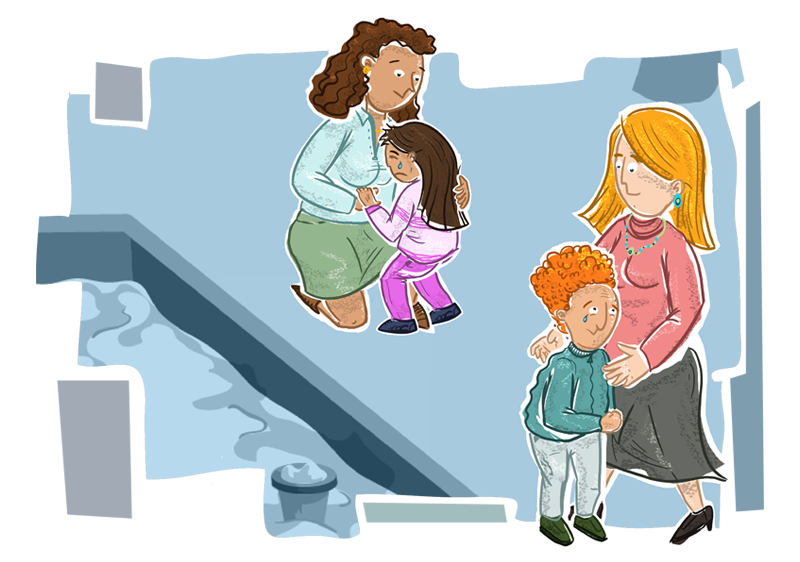What can I do? SR
Living Democracy » Parents » ДЕЦА (4 – 12 године) » АГРЕСИВНО ПОНАШАЊЕ » What can I do? SR
What can I do? – Tips for dealing with aggressive behavior
Are you all too familiar with the initial situation from the playground? In what follows, we have compiled a few behavioral guidelines and tips for you about how to deal with such situations in the future:
- Observe the situation carefully: is it just a minor tussle, a scuffle among peers? As such, it would be quite possible to let the situation continue for the time being and to observe it carefully. If everything remains fair, it is perhaps just a trial of strength, and parental intervention is not at all necessary. However, if a child begins to hit hard, acts unfairly, or if one of the participants is in danger, you must absolutely intervene and separate the ”brawlers“.
- Now, delay your reaction to the aggressive behavior of your daughter. Ranting, threatening, or even engaging in physical violence against her, does not further the child’s understanding that violence does not solve problems. Aggressive, angry behaviors in response to violence on the child’s part, in fact triggers a spiral of violence which can shake the foundation of any good upbringing, namely the trusting parent-child relationship.
Thus, make sure that no child can get hurt, separate them, create a physical distance between the contentious parties, remain calm and collected, and let situation cool down. Reassure yourself and your child: “This behavior is not acceptable, and we will come back to that in calmer circumstances.“ Thus, the problematic behavior is not discussed in an emotional state, to be discussed again later, rationally, and with the help of the mind. - When the emotions have subsided, we recommend a discussion about aggressive behavior, following the principle of “Nonviolent communication“ by Marshall B. Rosenberg. (For further information, click here.)
The basic assumption in Rosenberg’s 4-step model is that behind every human action (thus also behind the childish dispute in the aforementioned playground example), there are certain feelings and needs. As demonstrated by the aggression example, behind every aggressive action is a border transgression (see chapter: Why is my child aggressive? -Understanding the cause of aggression). These, and the feelings and needs associated with them, can be uncovered through compassionate communication. Peaceful ways of conflict resolution and satisfaction of needs can now be found through dialog. In what follows, here are the 4 steps toward a dialog in the sense of non-violent communication:
- Observations
Initially, try to describe precisely what kinds of behavior you have seen. Make sure not to interpret or evaluate the behavior. Your child, the receiver of your observations, should know exactly to what you refer. - Feelings
Then, share with the child the sentiments which your observations have triggered in you. Should you lack the words to describe your feelings, or those of your child, here is a list with a compilation of various feelings. - Needs
These comprise essential qualities which all human beings desire (or would like to have) in their lives. They include fundamental needs, such as sleep, food and drink, but also longing for love, security and self-realization.
What other needs are there? How do I state them accurately? Consult the list of needs here! Now, formulate them in conjunction with the feeling and state the resulting wish or request. - Requests
With this request you formulate an action or a behavior which results from the need. Here, you differentiate between requesting and desiring: requests are concrete actions, whereas wishes are more vague, relating to future conditions (e.g. “be kinder to older persons!“). Requests have a higher chance of success, as they define more concretely the desired behavior. Thus, requesting is more appropriate, particularly for educating small children.
Since it is difficult enough for adults to articulate their feelings and needs, it must not be assumed that children are able to express them more easily. Therefore, it is even more important that you, as parents, be sensitive to their utterances. By way of emphatic listening (clarifying and repeating of what has been said is a core concept of the model), the listeners can give the senders the opportunity to achieve clarity about their own thoughts, feelings and needs. (What is a sender? For basic information about communication please click here.) This is the optimal condition for finding common, alternative behavior patterns which require no physical violence to satisfy needs.
Exemplary dialog
How exactly could such a dialog following the fight on the playground be carried out? Imagine you are the mother. Your aim is to clarify the needs of your daughter and to show her different options on how to satisfy these needs in a non-violent way. Try to think first about the mother`s part of the dialog with the help of the indicated hints and questions. Then click on the speech bubbles to read a suggestion:











